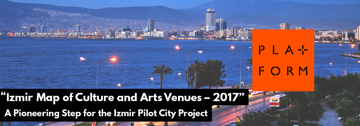KPY
“Izmir Map of Culture and Arts Venues – 2017”: A Pioneering Step for the Izmir Pilot City Project

October '17
Having determined as one of the primary objectives since its foundation, İzmir Culture Pla+form Initiative (IKPG) has been working on “İzmir Map of Culture and Arts Venues – 2017” for a while, a cultural mapping study for the identification and documentation of registered and unregistered cultural venues and spaces in İzmir. IKPG is a civil society initiative that aims to generate tools to increase communication among actors of arts and culture field in the city and to help their production to become more visible.
The need of data collection and information on the arts and culture venues and spaces - both independent and run by the local governments - their regional distribution in the city, duration of activity and the sorts of events organized by them has been identified in the very first search meeting of IKPG, hence “mapping, recording and listing” were set as primary objectives of the initiative. The need has also been brought up by the local government representatives, private sector executives and cultural actors during the “İzmir Pilot City – Self Assessment Workshop” on March, 2016.
Within this context, 246 venues that host and organize cultural events on a regularly basis in 11 districts of the city, which can be defined as “the center” and represent %69 of the total population (Çiğli, Karşıyaka, Bayraklı, Bornova, Buca, Karabağlar, Gaziemir, Konak, Balçova, Narlıdere ve Güzelbahçe) have been marked and listed in five categories: “public spaces”, “venues run by the local governments”, “venues run by the private sector”, “independent venues” and “open air spaces where culture and arts activities are being organized regularly” with a participatory approach to the process that directly involves the actors in the field.
The first edition “The İzmir Map of Culture and Arts Venues – 2017” is planned to be released at the end of 2017 and IKPG aims to contribute to the generation of participatory and effective cultural policies by regularly updating its database and widening its coverage to the whole city with the support of civil society and volunteers.